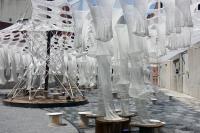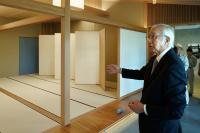Spaces Milan - co-working space in the heart of Milan Porta Nuova
Milano, Italy
On the example of the historical tradition of the entrances of the Milanese buildings, the project of Spaces Milano opens to the city through an attractive entrance, clearly visible from the outside.
The stone of the building facade is here reinterpreted and becomes an interior decoration; the lighting enhances the relationship between stone and other materials and converts the entrance into an urban landmark.
The building faces the Bastioni and turns towards Piazza XXV Aprile, one of the most interesting examples of urban renovation in Milan. Spaces creates a community environment that offers multiple spatial solutions to create networks. Designing this ecosystem is like designing a small town or a large collective house. Each space is a useful place for the community that allows multiple exchanges , from formal ones to informal and spontaneous ones. Even a hidden corner, if well designed, can turn into a great place of work and unexpected meeting. The strength of the project relies on combining the informal model of this kind of spaces with the sensible aesthetic and rigorousness of the city, of its buildings and its entrances. The project focuses on the potential of a flexible and innovative space and at the same time on the quality of the materials. The project picks up from a first generation of co-working, emphasizing exclusively the informal and playful image of the spaces, that were built as an only alternative to the excessively corporate dimension characterizing the office projects of the ‘international style’. Spaces Milan tries to overcome this dichotomy taking advantage of the potentialities of both scales. The common spaces have been conceived with an aesthetic rigor and attention to details and materials similar to that of the interior design project instead of a collective environment. At the ground floor a great attention was paid to the lighting design. Seen from outside, lights and lamps are perceived as iridescent architectures, flying carpets that light up the Milanese nights. Colours and materials define in a subtle way the character of each space: from the bright and playful colours of the areas near the entrance to the warm walnut wood of the cafeteria, from the soft palette of the working area and of the booths to the neutral colours of the quiet area. At the office floors , the abstract materiality of glass walls framed with black steel is opposed to the warm oak of the flooring. Along each corridor, the lights, hanged with a 30 degree inclination, replace the false ceiling and emphasize the sense of movement. Thanks to a series of folding walls, the sequence of meeting rooms of the basement easily becomes a unique, continuous event space.
The terrace on the rooftop, paved with a wooden deck and shaded by a thin steel structure, is conceived as a domestic living room, open to the skyline of a constantly changing city.
The building faces the Bastioni and turns towards Piazza XXV Aprile, one of the most interesting examples of urban renovation in Milan. Spaces creates a community environment that offers multiple spatial solutions to create networks. Designing this ecosystem is like designing a small town or a large collective house. Each space is a useful place for the community that allows multiple exchanges , from formal ones to informal and spontaneous ones. Even a hidden corner, if well designed, can turn into a great place of work and unexpected meeting. The strength of the project relies on combining the informal model of this kind of spaces with the sensible aesthetic and rigorousness of the city, of its buildings and its entrances. The project focuses on the potential of a flexible and innovative space and at the same time on the quality of the materials. The project picks up from a first generation of co-working, emphasizing exclusively the informal and playful image of the spaces, that were built as an only alternative to the excessively corporate dimension characterizing the office projects of the ‘international style’. Spaces Milan tries to overcome this dichotomy taking advantage of the potentialities of both scales. The common spaces have been conceived with an aesthetic rigor and attention to details and materials similar to that of the interior design project instead of a collective environment. At the ground floor a great attention was paid to the lighting design. Seen from outside, lights and lamps are perceived as iridescent architectures, flying carpets that light up the Milanese nights. Colours and materials define in a subtle way the character of each space: from the bright and playful colours of the areas near the entrance to the warm walnut wood of the cafeteria, from the soft palette of the working area and of the booths to the neutral colours of the quiet area. At the office floors , the abstract materiality of glass walls framed with black steel is opposed to the warm oak of the flooring. Along each corridor, the lights, hanged with a 30 degree inclination, replace the false ceiling and emphasize the sense of movement. Thanks to a series of folding walls, the sequence of meeting rooms of the basement easily becomes a unique, continuous event space.
The terrace on the rooftop, paved with a wooden deck and shaded by a thin steel structure, is conceived as a domestic living room, open to the skyline of a constantly changing city.
- arkkitehdit
- Laboratorio Permanente
- Year
- 2017
- Client
- Regus
- Team
- Nicola Russi, Angelica Sylos Labini, Emanuela Forcolini, Luca Cozzani, Alessandro Zanoletti, Marion Bisiaux
- Constructor
- Constructors Srl













